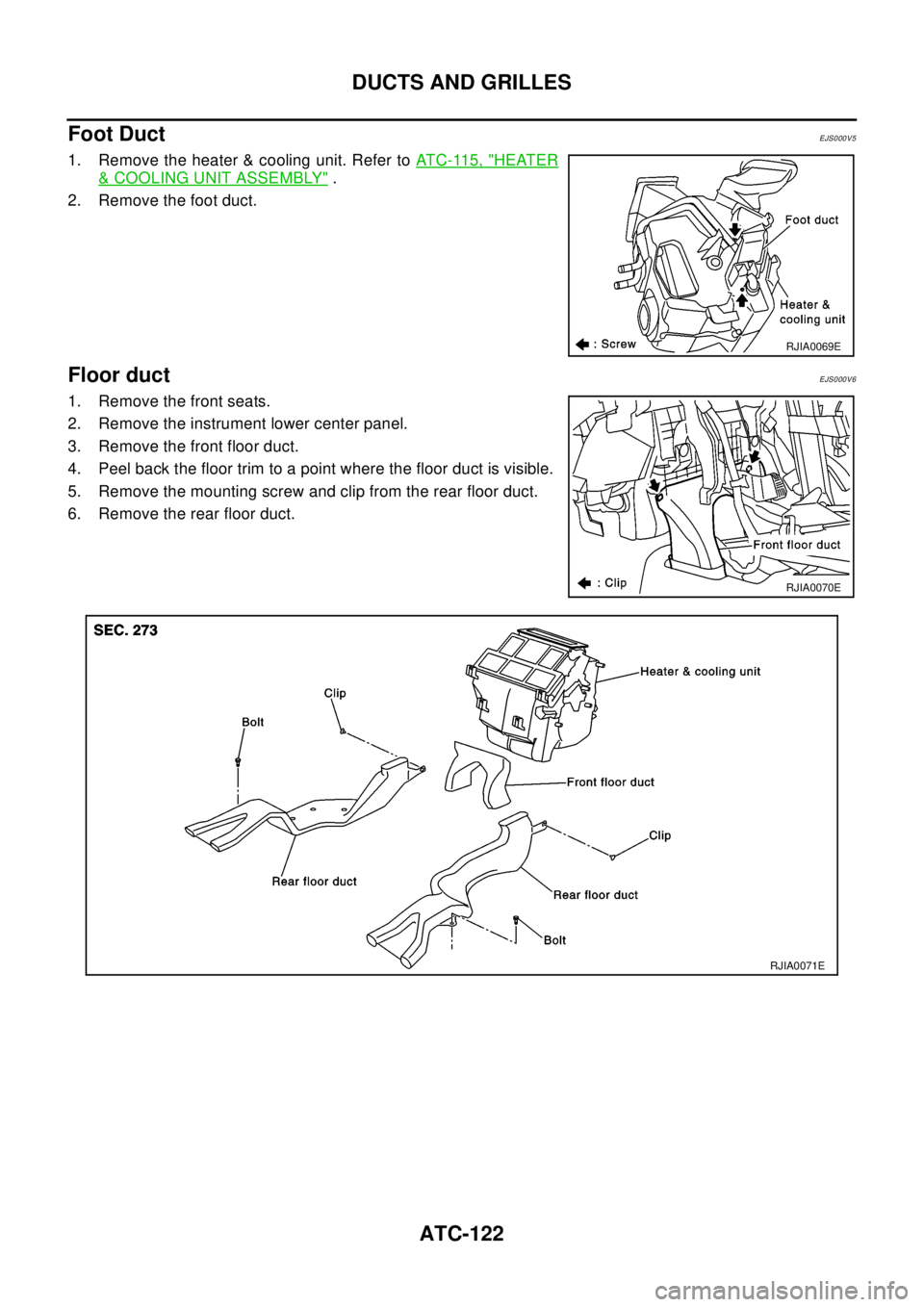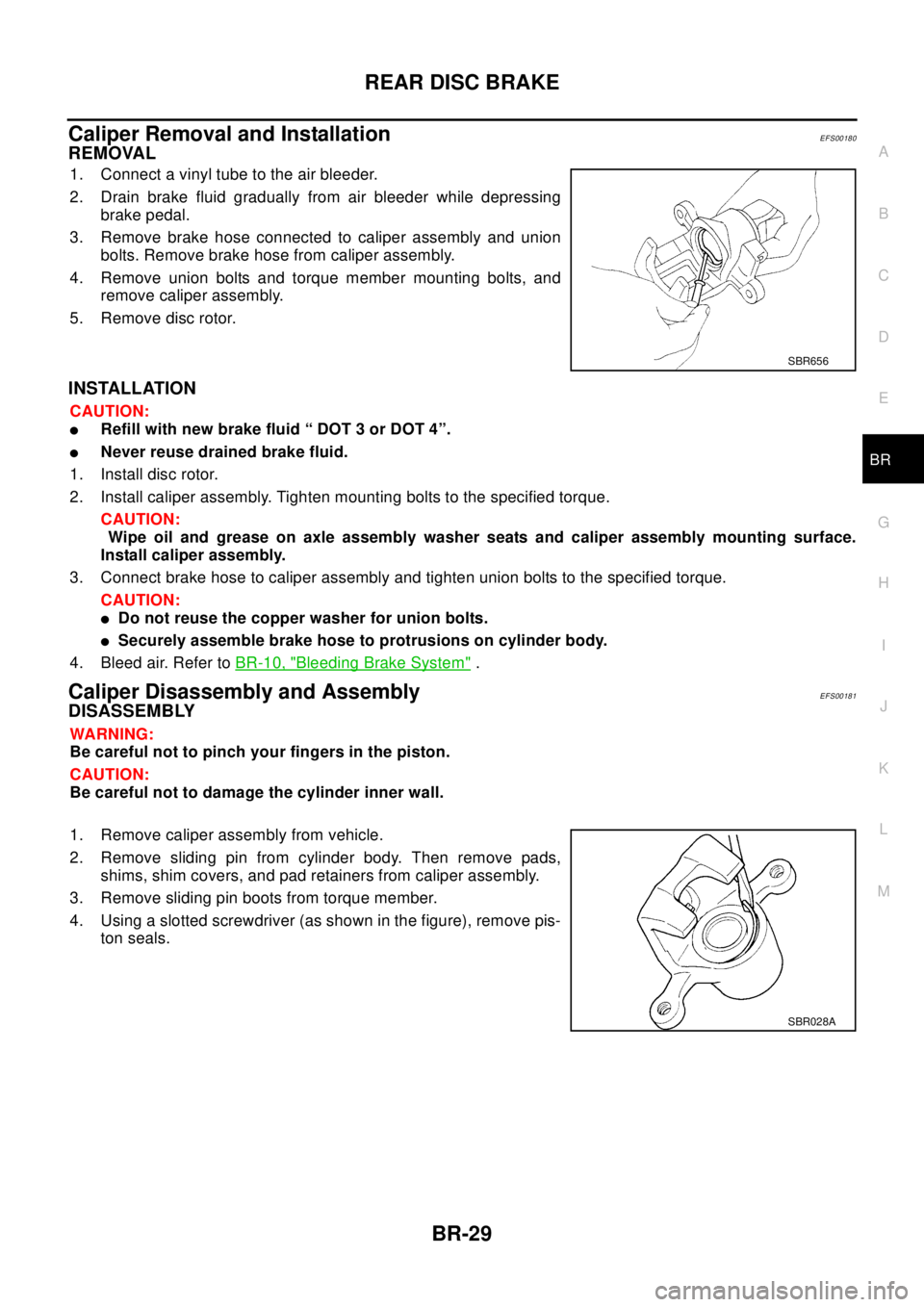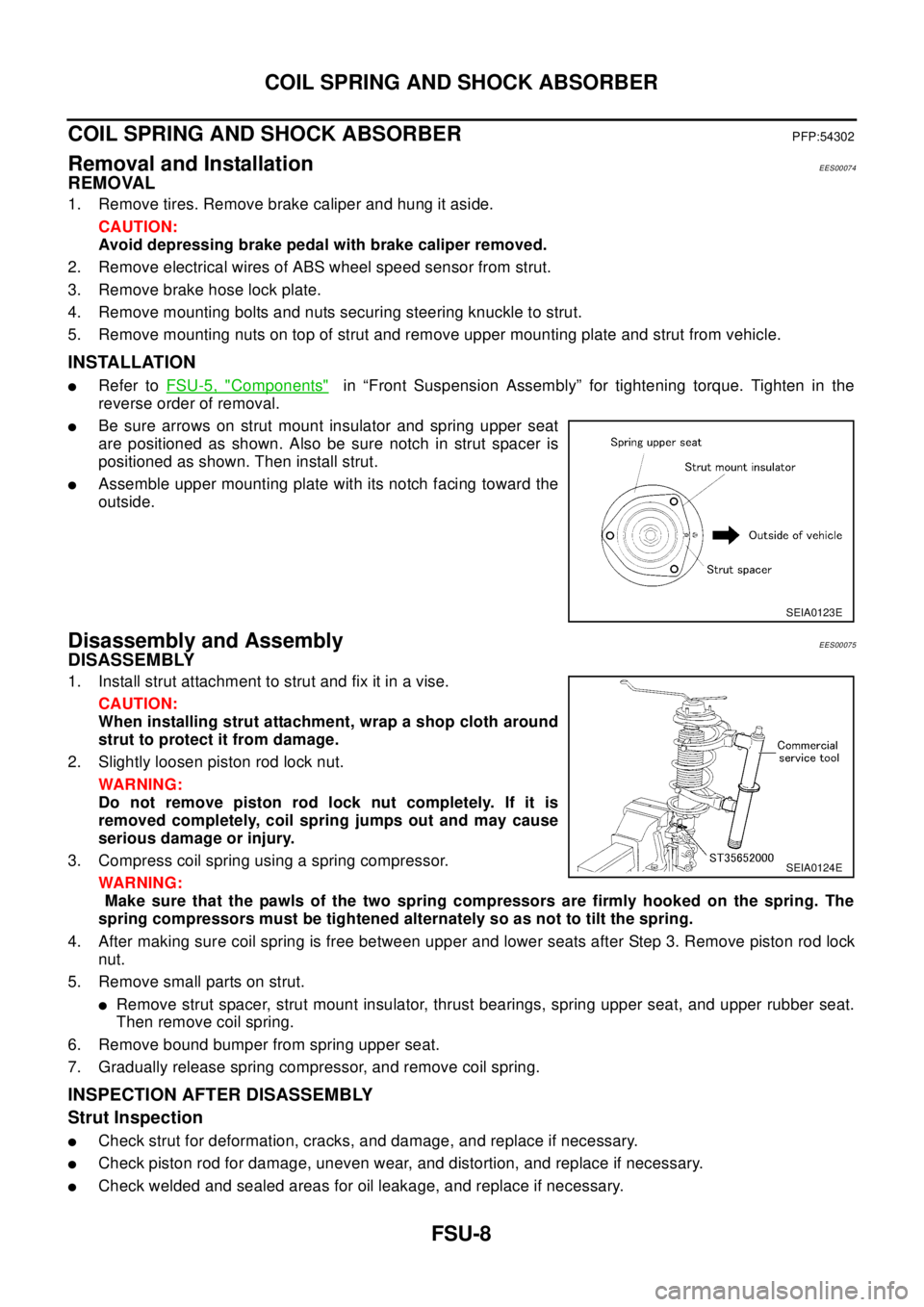2003 NISSAN X-TRAIL remove seats
[x] Cancel search: remove seatsPage 700 of 3066

ATC-122
DUCTS AND GRILLES
Foot Duct
EJS000V5
1. Remove the heater & cooling unit. Refer toATC-115, "HEATER
&COOLING UNIT ASSEMBLY".
2. Remove the foot duct.
Floor ductEJS000V6
1. Remove the front seats.
2. Remove the instrument lower center panel.
3. Remove the front floor duct.
4. Peel back the floor trim to a point where the floor duct is visible.
5. Remove the mounting screw and clip from the rear floor duct.
6. Remove the rear floor duct.
RJIA0069E
RJIA0070E
RJIA0071E
Page 857 of 3066

FRONT DISC BRAKE
BR-23
C
D
E
G
H
I
J
K
L
MA
B
BR
3. Remove union bolts and torque member mounting bolts, and
remove caliper assembly.
4. Remove disc rotor.
INSTALLATION
CAUTION:
lRefill with new brake fluid “DOT 3” or “DOT 4”.
lNever reuse drained brake fluid.
1. Install disc rotor.
2. Install caliper assembly. Tighten mounting bolts to the specified torque.
CAUTION:
Before installing caliper assembly, wipe oil and grease on the trailing arm washer seats and cali-
per assembly mounting surface.
3. Connect brake hose to caliper assembly and tighten union bolts to the specified torque.
CAUTION:
lDo not reuse the copper washer for union bolts.
lSecurely assemble brake hose to protrusions on cylinder body.
4. Bleed air. Refer toBR-10, "
Bleeding Brake System".
Caliper Disassembly and AssemblyEF S0 00 CK
DISASSEMBLY
WA RN ING:
Be careful not to pinch your fingers in the piston.
CAUTION:
Be careful not to damage the cylinder inner wall.
1. Place a wooden block as shown in the figure. Blow air into union
bolt mounting hole to remove pistons and piston boots.
SBR979B
BRB0032D
Page 863 of 3066

REAR DISC BRAKE
BR-29
C
D
E
G
H
I
J
K
L
MA
B
BR
Caliper Removal and InstallationEFS00180
REMOVAL
1. Connect a vinyl tube to the air bleeder.
2. Drain brake fluid gradually from air bleeder while depressing
brake pedal.
3. Remove brake hose connected to caliper assembly and union
bolts. Remove brake hose from caliper assembly.
4. Remove union bolts and torque member mounting bolts, and
remove caliper assembly.
5. Remove disc rotor.
INSTALLATION
CAUTION:
lRefill with new brake fluid “ DOT 3 or DOT 4”.
lNever reuse drained brake fluid.
1. Install disc rotor.
2. Install caliper assembly. Tighten mounting bolts to the specified torque.
CAUTION:
Wipe oil and grease on axle assembly washer seats and caliper assembly mounting surface.
Install caliper assembly.
3. Connect brake hose to caliper assembly and tighten union bolts to the specified torque.
CAUTION:
lDo not reuse the copper washer for union bolts.
lSecurely assemble brake hose to protrusions on cylinder body.
4. Bleed air. Refer toBR-10, "
Bleeding Brake System".
Caliper Disassembly and AssemblyEFS00181
DISASSEMBLY
WA RN ING:
Be careful not to pinch your fingers in the piston.
CAUTION:
Be careful not to damage the cylinder inner wall.
1. Remove caliper assembly from vehicle.
2. Remove sliding pin from cylinder body. Then remove pads,
shims, shim covers, and pad retainers from caliper assembly.
3. Remove sliding pin boots from torque member.
4. Using a slotted screwdriver (as shown in the figure), remove pis-
ton seals.
SBR656
SBR028A
Page 1323 of 3066
![NISSAN X-TRAIL 2003 Electronic Repair Manual DTC P0300 - P0304 MULTIPLE CYLINDER MISFIRE, NO. 1 - 4 CYLINDER MIS-
FIRE
EC-209
[QR (WITH EURO-OBD)]
C
D
E
F
G
H
I
J
K
L
MA
EC
5.CHECK IGNITION SPARK
1. Disconnect ignition coil assembly from rocker NISSAN X-TRAIL 2003 Electronic Repair Manual DTC P0300 - P0304 MULTIPLE CYLINDER MISFIRE, NO. 1 - 4 CYLINDER MIS-
FIRE
EC-209
[QR (WITH EURO-OBD)]
C
D
E
F
G
H
I
J
K
L
MA
EC
5.CHECK IGNITION SPARK
1. Disconnect ignition coil assembly from rocker](/manual-img/5/57402/w960_57402-1322.png)
DTC P0300 - P0304 MULTIPLE CYLINDER MISFIRE, NO. 1 - 4 CYLINDER MIS-
FIRE
EC-209
[QR (WITH EURO-OBD)]
C
D
E
F
G
H
I
J
K
L
MA
EC
5.CHECK IGNITION SPARK
1. Disconnect ignition coil assembly from rocker cover.
2. Connect a known good spark plug to the ignition coil assembly.
3. Place end of spark plug against a suitable ground and crank engine.
4. Check for spark.
OK or NG
OK >> GO TO 6.
NG >> Check ignition coil, power transistor and their circuits.
Refer toEC-334, "
IGNITION SIGNAL".
6.CHECK SPARK PLUGS
Remove the spark plugs and check for fouling, etc.
OK or NG
OK >> GO TO 7.
NG >> Repair or replace spark plug(s) with standard type
one(s). For spark plug type, refer toMA-25, "
Checking
and Changing Spark Plugs".
7.CHECK COMPRESSION PRESSURE
Check compression pressure. Refer toEM-52, "
CHECKING COMPRESSION PRESSURE".
OK or NG
OK >> GO TO 8.
NG >> Check pistons, piston rings, valves, valve seats and cylinder head gaskets.
8.CHECK FUEL PRESSURE
1. Install all removed parts.
2. Release fuel pressure to zero. Refer toEC-34, "
FUEL PRESSURE RELEASE".
3. Install fuel pressure gauge and check fuel pressure. Refer toEC-34, "
FUEL PRESSURE CHECK".
OK or NG
OK >> GO TO 9.
NG >> Follow the construction of "FUEL PRESSURE CHECK".
SEF575Q
SEF156I
Standard:
1,190 kPa (11.9 bar, 12.1 kg/cm2, 172 psi)/250
rpm
Minimum:
990 kPa (9.9 bar, 10.1 kg/cm
2, 144 psi)/250 rpm
Difference between each
cylinder:98 kPa (0.98 bar, 1.0 kg/cm
2, 14 psi)/250 rpm
At idle: Approx. 350 kPa (3.5 bar, 3.7 kg/cm
2,51psi)
Page 2143 of 3066
![NISSAN X-TRAIL 2003 Electronic Repair Manual CYLINDER HEAD
EM-173
[YD22DDTi]
C
D
E
F
G
H
I
J
K
L
MA
EM
CYLINDER HEADPFP:11041
On-Vehicle ServiceEBS00BPL
CHECKING COMPRESSION PRESSURE
1. Warm up engine thoroughly. Then, stop it.
2. Using CONSULT- NISSAN X-TRAIL 2003 Electronic Repair Manual CYLINDER HEAD
EM-173
[YD22DDTi]
C
D
E
F
G
H
I
J
K
L
MA
EM
CYLINDER HEADPFP:11041
On-Vehicle ServiceEBS00BPL
CHECKING COMPRESSION PRESSURE
1. Warm up engine thoroughly. Then, stop it.
2. Using CONSULT-](/manual-img/5/57402/w960_57402-2142.png)
CYLINDER HEAD
EM-173
[YD22DDTi]
C
D
E
F
G
H
I
J
K
L
MA
EM
CYLINDER HEADPFP:11041
On-Vehicle ServiceEBS00BPL
CHECKING COMPRESSION PRESSURE
1. Warm up engine thoroughly. Then, stop it.
2. Using CONSULT-II, make sure no error codes are indicated for self-diagnosis items. Refer toEC-672,
"Basic Inspection".
lDo not disconnect CONSULT-II until the end of this operation; it will be used to check engine rpm and
for error detection at the end of this operation.
3. Disconnect the negative battery terminal.
4. Remove the following parts.
lCharge air cooler (Refer toEM-114, "Removal and Installation".)
5. To prevent fuel from being injected during inspection, remove
fuel supply pump fuse [ENG CONT (20A)] from fuse box on the
left side of engine compartment.
lAmong marks on fuse box, [ENG CONT 3 (20A)] is for fuel
supply pump fuse.
6. Remove glow plugs from all the cylinders. Refer toEM-130,
"Removal and Installation".
CAUTION:
lBefore removal, clean the surrounding area to prevent
entry of any foreign materials into the engine.
lCarefully remove glow plugs to prevent any damage or
breakage.
lHandle with care to avoid applying any shock to glow plugs.
7. Install adapter to installation holes of glow plugs and connect
compression gauge for diesel engine.
8. Connect battery negative terminal.
9. Set the ignition switch to “START” and crank. When gauge
pointer stabilizes, read compression pressure and engine rpm.
Repeat the above steps for each cylinder.
lAlways use a fully-charged battery to obtain specified engine
speed.
Unit:kPa(bar,kg/cm2, psi)/rpm
lWhen engine rpm is out of the specified range, check the specific gravity of battery liquid. Measure
again under corrected conditions.
lIf engine rpm exceeds the limit, check valve clearance and combustion chamber components (valves,
valve seats, cylinder head gaskets, piston rings, pistons, cylinder bores, cylinder block upper and lower
surfaces) and measure again.
lIf compression pressure is low in some cylinders, apply engine oil from glow plug installation hole. Then
check pressure again.
–If compression pressure becomes normal after applying oil, piston ring may be worn or damaged.
Check piston ring for malfunction. If any, replace piston ring.
–If compression pressure is still low after applying oil, valve may be malfunctioning. Check valve for mal-
function. If contact malfunction is found, replace valve or valve seat.
lIf compression pressure in adjacent two cylinders is low after applying oil, pressure may be leaking
from gasket. In this case, replace cylinder head gasket.
SBIA0192E
:18-21N·m(1.8-2.2kg-m,13-15ft-lb)
Standard MinimumDifference limit between
cylinders
2,893 (28.9, 29.5, 419)/
2002,452 (24.52, 25.0, 356)/
200490 (4.90, 5.0, 71)/200
SEM112G
Page 2149 of 3066
![NISSAN X-TRAIL 2003 Electronic Repair Manual CYLINDER HEAD
EM-179
[YD22DDTi]
C
D
E
F
G
H
I
J
K
L
MA
EM
5. Remove valve oil seals using valve oil seal puller.
6. Remove valve spring seats.
7. Before removing valve spring seats, perform valve seat NISSAN X-TRAIL 2003 Electronic Repair Manual CYLINDER HEAD
EM-179
[YD22DDTi]
C
D
E
F
G
H
I
J
K
L
MA
EM
5. Remove valve oil seals using valve oil seal puller.
6. Remove valve spring seats.
7. Before removing valve spring seats, perform valve seat](/manual-img/5/57402/w960_57402-2148.png)
CYLINDER HEAD
EM-179
[YD22DDTi]
C
D
E
F
G
H
I
J
K
L
MA
EM
5. Remove valve oil seals using valve oil seal puller.
6. Remove valve spring seats.
7. Before removing valve spring seats, perform valve seat contact
check. Refer toEM-181, "
Va l v e S e a t C o n ta ct".
8. Before removing valve guides, perform valve guide clearance
check. Refer toEM-180, "
Valve Guide Clearance".
ASEMBLY
1. Install valve guides. Refer toEM-180, "Valve Guide Clearance".
2. Install valve seats. Refer toEM-181, "
Valve Seat Replacement".
3. Using valve oil seal drift, install valve oil seals referring to the
dimension shown in the figure.
lDifferent parts are used for valve location, Identify by the rub-
ber color.
4. Install valve spring seats.
5. Install valves.
lInstall the valves with bigger outer diameter to intake valve
side.
lNote that valve layout here is different from that of conventional engine.
6. Install valve spring.
lWhen installing valve spring, make sure that a smaller pitch
side (identification paint-applied side) faces the cylinder head.
7. Install valve spring retainers.
8. Using valve spring compressor, compress valve springs.
Then install valve collets using magnetic hand.
lAfter installing valve collets, tap the stem end using a plastic
hammer, and check the installation status.
9. Install valve lifters and adjusting shims to the same positions as
before.
INSPECTION AFTER DISASSEMBLY
Cylinder Head Distortion
Using straightedge and feeler gauge, check the bottom of the cylin-
der head for distortion.
JEM153G
For intake : Black
For exhaust : Brown
JEM165G
Identification color : Yellow
FEM080
Limit : 0.04 mm (0.0016 in)
SEM496G
Page 2247 of 3066

FSU-8
COIL SPRING AND SHOCK ABSORBER
COIL SPRING AND SHOCK ABSORBER
PFP:54302
Removal and InstallationEES00074
REMOVAL
1. Remove tires. Remove brake caliper and hung it aside.
CAUTION:
Avoid depressing brake pedal with brake caliper removed.
2. Remove electrical wires of ABS wheel speed sensor from strut.
3. Remove brake hose lock plate.
4. Remove mounting bolts and nuts securing steering knuckle to strut.
5. Remove mounting nuts on top of strut and remove upper mounting plate and strut from vehicle.
INSTALLATION
lRefer toFSU-5, "Components"in “Front Suspension Assembly” for tightening torque. Tighten in the
reverse order of removal.
lBe sure arrows on strut mount insulator and spring upper seat
are positioned as shown. Also be sure notch in strut spacer is
positioned as shown. Then install strut.
lAssemble upper mounting plate with its notch facing toward the
outside.
Disassembly and AssemblyEES00075
DISASSEMBLY
1. Install strut attachment to strut and fix it in a vise.
CAUTION:
When installing strut attachment, wrap a shop cloth around
strut to protect it from damage.
2. Slightly loosen piston rod lock nut.
WAR NIN G:
Do not remove piston rod lock nut completely. If it is
removed completely, coil spring jumps out and may cause
serious damage or injury.
3. Compress coil spring using a spring compressor.
WAR NIN G:
Make sure that the pawls of the two spring compressors are firmly hooked on the spring. The
spring compressors must be tightened alternately so as not to tilt the spring.
4. After making sure coil spring is free between upper and lower seats after Step 3. Remove piston rod lock
nut.
5. Remove small parts on strut.
lRemove strut spacer, strut mount insulator, thrust bearings, spring upper seat, and upper rubber seat.
Then remove coil spring.
6. Remove bound bumper from spring upper seat.
7. Gradually release spring compressor, and remove coil spring.
INSPECTION AFTER DISASSEMBLY
Strut Inspection
lCheck strut for deformation, cracks, and damage, and replace if necessary.
lCheck piston rod for damage, uneven wear, and distortion, and replace if necessary.
lCheck welded and sealed areas for oil leakage, and replace if necessary.
SEIA0123E
SEIA0124E
Page 2496 of 3066

MA-4
DESCRIPTION
DESCRIPTION
PFP:00000
Pre-delivery Inspection ItemsELS000AK
Shown below are Pre-delivery Inspection Items required for the new vehicle. It is recommended that
necessary items other than those listed here be added, paying due regard to the conditions in each
country.
Perform applicable items on each model. Consult text of this section for specifications.
UNDER HOOD — engine off
Radiator coolant level and coolant hose connections for leaks
Battery fluid level, specific gravity and conditions of battery terminals
Drive belts tension
Fuel filter for water or dusts (Diesel only), and fuel lines and connections for leaks
Engine oil level and oil leaks
Clutch and brake reservoir fluid level and fluid lines for leaks
Windshield and rear window washer and headlamp cleaner reservoir fluid level
Power steering reservoir fluid level and hose connections for leaks
ON INSIDE AND OUTSIDE
Remove front spring/strut spacer (If applicable)
Operation of all instruments, gauges, lights and accessories
Operation of horn(s), wiper and washer
Steering lock for operation
Check air conditioner for gas leaks
Front and rear seats, and seat belts for operation
All moldings, trims and fittings for fit and alignment
All windows for operation and alignment
Hood, trunk lid, door panels for fit and alignment
Latches, keys and locks for operation
Weatherstrips for adhesion and fit
Headlamp aiming
Tighten wheel nuts (Inc. inner nuts if applicable)
Tire pressure (Inc. spare tire)
Check front wheels for toe-in
Install clock/voltmeter/room lamp fuse (If applicable)
Install deodorizing filter to air conditioner (If applicable)
Remove wiper blade protectors (If applicable)
UNDER BODY
Manual transmission/transaxle, transfer and differential gear oil level
Brake and fuel lines and oil/fluid reservoirs for leaks
Tighten bolts and nuts of steering linkage and gear box, suspension, propeller shafts and drive shafts
Tighten rear body bolts and nuts (Models with wooden bed only)
ROAD TEST
Clutch operation
Parking brake operation
Service brake operation
Automatic transmission/transaxle shift timing and kickdown
Steering control and returnability
Engine performance
Squeaks and rattles
ENGINE OPERATING AND HOT
Adjust idle speed
Automatic transmission/transaxle fluid level